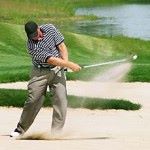Improving Golf Performance
Shoemaker, a noted golf coach and the author of Extraordinary Putting, explains why most thinking is bad for your game.
“It’s easy for people to accept the fact that negative thinking can be a source of interference. I’ve found that the real challenge is to have people see for themselves that positive thinking can be just as much of a problem. My experience of positive thinking is that it’s just more thinking, a mental process while we’re in a physical activity. It’s also an indication of doubt. Positive thinking is an overlay of doubt; it’s a strategy to overcome negative thinking, and while it may have better effects than negative thinking, I’ve never seen it fully promote peace of mind and freedom.”
The way to get out of thinking and into playing the game is having the ability to get into a flow state. Athletes call this “getting into the zone”. It is a mental state where thoughts disappear and the person simply plays the game. hypnosis is known to induce exactly that flow state. Tiger Woods is an expert in getting into the zone.
This brief extract from Golf Digest, appears to confirm Tiger’s training included hypnosis.
“Woods’ ability to produce peak performance by ‘willing myself into the zone’ is unprecedented. At age 13, Tiger began mental training with Dr. Jay Brunza, a family friend and psychologist. Among the techniques Brunza used were subliminal tapes and hypnosis. ‘The first time Jay hypnotized Tiger, he had him stick his arm straight out and told him that it couldn’t be moved, ‘Earl [Tiger’s father] says. ‘I tried, but I couldn’t pull it down. [Tiger says hypnosis is] ‘inherent in what I do now.”
In a study conducted on the effects of hypnosis on flow states and golf performance. at the Center for Sport and Exercise Science, Sheffield Hallam University, researchers examined the effects of hypnotic intervention on flow states and golf-chipping performance of 3 participants. The intervention involved teaching the golfers relaxation, imagery, hypnotic induction, hypnotic regression, and trigger control procedures over 5 weeks and 7 trials. Analysis indicated that the 3 participants increased their mean golf-chipping performance from the trials in Baseline 1 to intervention, with 2 returning to Baseline 1 performance after the intervention phase at Baseline 2. The intensity of flow experienced by the participants during the performance trials was measured using Jackson and Marsh’s 1996 Flow State Scale. Two participants experienced higher flow during the intervention phase and much lower flow during Baselines 1 and 2. Finally, participants reported that the intervention seemed useful in keeping them confident, relaxed, and in control. These results support the hypothesis that relaxation, imagery & hypnosis can improve golf-chipping performance and increase feelings and cognitions associated with flow.
I see many golfers, both professional and amateur, who want to improve their game. We work on figuring out the limiting beliefs the golfer has about himself. Typically, these beliefs have an impact on performance of all kinds. We then work on the ability to maintain a flow state no matter what is happening in the game. By doing so the golfer not only plays significantly better, they also feel more relaxed and enjoy the game more.
To learn more about enhancing your golf game through proven techniques and to improve golf performance in Atlanta, call Inga Chamberlain at 770-560-4861.


